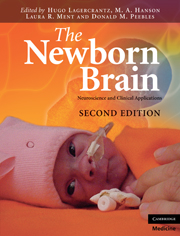Book contents
- Frontmatter
- Contents
- List of contributors
- Preface to the First Edition
- Preface to the Second Edition
- 1 Reflections on the origins of the human brain
- Section 1 Making of the brain
- Section 2 Sensory systems and behavior
- Section 3 Radiological and neurophysiological investigations
- 13 Imaging the neonatal brain
- 14 Electroencephalography and amplitude-integrated EEG
- 15 Emergence of spontaneous and evoked electroencephalographic activity in the human brain
- Section 4 Clinical aspects
- Section 5 Follow-up
- Section 6 Consciousness
- Index
- Plate section
- References
14 - Electroencephalography and amplitude-integrated EEG
from Section 3 - Radiological and neurophysiological investigations
Published online by Cambridge University Press: 01 March 2011
- Frontmatter
- Contents
- List of contributors
- Preface to the First Edition
- Preface to the Second Edition
- 1 Reflections on the origins of the human brain
- Section 1 Making of the brain
- Section 2 Sensory systems and behavior
- Section 3 Radiological and neurophysiological investigations
- 13 Imaging the neonatal brain
- 14 Electroencephalography and amplitude-integrated EEG
- 15 Emergence of spontaneous and evoked electroencephalographic activity in the human brain
- Section 4 Clinical aspects
- Section 5 Follow-up
- Section 6 Consciousness
- Index
- Plate section
- References
Summary
Introduction
The electroencephalogram (EEG) records electrical activity from the cerebral cortex. This activity is derived from synchronized postsynaptic action potentials from large numbers of neurons, reflecting the functional state of the brain. Thousands of publications have described the EEG during normal and abnormal conditions, in subjects of different ages, including very preterm newborn infants. Spontaneous recurrent action potentials within thalamocortical relay cells, the reticular thalamic nucleus, and cortical pyramidal cells constitute the basis for the EEG activity (Steriade et al., 1990). This activity is synchronized by recurrent connections between the thalamocortical relay cells and the reticular thalamic nucleus, and by thalamocortical connections. In adults, intracortical connections generate higher frequency EEG components during mental processes and active wakefulness. During arousal, cholinergic (and norepinephrinergic) afferents from the brainstem exert an excitatory depolarizing effect on thalamocortical and cortical cells and inhibit the reticular thalamic cells. The net result of arousal is a reduction of synchronous low-frequency activity, and an increase of asynchronous high-frequency activity. The neurophysiological basis for the EEG in newborn preterm and term infants is not very well known. The cortical subplate zone, a structure that is present in the fetus during the second trimester and which is the origin of thalamocortical and corticocortical afferents, probably modulates EEG activity via cortical connections (Kostovic & Jovanov-Milosevic, 2006). The subplate zone is probably also important for the mechanisms underlying spontaneous activity transients (SAT) in the discontinuous EEG of very preterm infants. The SATs are characterized by very-low-frequency waves with higher-frequency components superimposed.
- Type
- Chapter
- Information
- The Newborn BrainNeuroscience and Clinical Applications, pp. 211 - 228Publisher: Cambridge University PressPrint publication year: 2010
References
- 1
- Cited by



